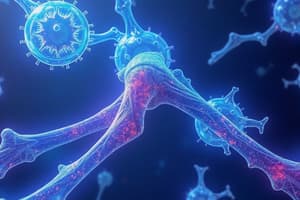Podcast
Questions and Answers
ما هو دور الخلايا العظمية في الجسم؟
ما هو دور الخلايا العظمية في الجسم؟
- الكشف عن أو تحسس القوى الميكانيكية وتنظيم مستويات الكالسيوم والفوسفات (correct)
- إزالة العظم القديم أو التالف
- تصنيع المصفوفة العظمية وتعدينها
- كسر الأنسجة العظمية القديمة
ما هي وظيفة خلية العظم؟
ما هي وظيفة خلية العظم؟
- تكوين مصفوفة عظمية جديدة (correct)
- التقاط إشارات كهربية
- إزالة العظم القديم أو التالف
- كسر النسيج العظمي القديم
ما هي دور خلايا العظم في عملية التكلس؟
ما هي دور خلايا العظم في عملية التكلس؟
- إفراز مصفوفة غنية بالبروتين (correct)
- إزالة الأنسجة العظمية
- التغذية على نطاق واسع
- تحفيز تكوين والشفاء العظمي
ما هي دور خلايا العظام في دورة تجديد العظام؟
ما هي دور خلايا العظام في دورة تجديد العظام؟
أي من هذه الخلايا تقوم بكسر أو تفكيك نسيج العظام؟
أي من هذه الخلايا تقوم بكسر أو تفكيك نسيج العظام؟
ما هو دور الخلايا العظمية في تشكيل الجسم؟
ما هو دور الخلايا العظمية في تشكيل الجسم؟
ما المادة الرئيسية التي يتكون منها مصفوفة العظم؟
ما المادة الرئيسية التي يتكون منها مصفوفة العظم؟
ما نتيجة عملية التكلس في العظام؟
ما نتيجة عملية التكلس في العظام؟
ما دور مصفوفة العظم في عملية ترميم العظام؟
ما دور مصفوفة العظم في عملية ترميم العظام؟
أي خلية تقوم بدور رئيسي في تحليل المصفوفة العضوية للعظام؟
أي خلية تقوم بدور رئيسي في تحليل المصفوفة العضوية للعظام؟
كيف تسهم خلايا العظام ذاتية التجديد (osteocytes) في صحة أنسجة العظام؟
كيف تسهم خلايا العظام ذاتية التجديد (osteocytes) في صحة أنسجة العظام؟
Osteogenic cells are found in both periosteum and endosteum.
Osteogenic cells are found in both periosteum and endosteum.
Osteoblasts secrete bone matrix and deposit phosphate salts in it.
Osteoblasts secrete bone matrix and deposit phosphate salts in it.
Osteocytes are branched cells present singly in lacunae.
Osteocytes are branched cells present singly in lacunae.
Compact bone is mainly found in the epiphysis of long bones.
Compact bone is mainly found in the epiphysis of long bones.
Haversian canals are longitudinal cylinders formed of concentric bone lamellae.
Haversian canals are longitudinal cylinders formed of concentric bone lamellae.
Volkmann's canals connect the Haversian canals together and run longitudinally.
Volkmann's canals connect the Haversian canals together and run longitudinally.
Flashcards are hidden until you start studying
Study Notes
Bone Cells: A Vital Trio for Skeletal Health
Beneath the hard exoskeleton of our bodies, a dynamic network of cells keeps our bones strong, flexible, and resilient. Three primary cell types — osteocytes, osteoblasts, and osteoclasts — collaborate and communicate to maintain the health of our skeletal system, while the bone matrix provides structural support and a foundation for these cells to function.
Osteocytes: The Sentinels of Bone
Osteocytes are the most abundant bone cells, responsible for sensing mechanical forces and regulating calcium and phosphate levels in the body. They reside within small cavities called lacunae, which are connected by tiny canals called canaliculi, allowing them to communicate with neighboring osteocytes and other bone cells. Osteocytes play a crucial role in maintaining bone homeostasis by detecting mechanical stress and signaling the need for bone repair or remodeling.
Osteoblasts: The Builders of Bone
Osteoblasts are responsible for synthesizing and mineralizing bone matrix, forming new bone tissue. They secrete a protein-rich extracellular matrix, which becomes calcified and rigid, creating the bone's framework. Osteoblasts also release growth factors, which stimulate bone formation and healing.
Osteoclasts: The Dismantlers of Bone
Osteoclasts are specialized cells that resorb or break down bone tissue. They remove old or damaged bone, making room for new bone formations and supporting other bodily functions. Osteoclasts are essential for proper bone remodeling and maintaining calcium homeostasis in the body.
Bone Matrix: The Foundation of Bone Strength
The bone matrix is a complex, organic substance made up of collagen fibers and inorganic minerals, primarily calcium and phosphate. This matrix provides a rigid structure for the bone cells and serves as a scaffold for bone repair and remodeling. The bone matrix also helps to maintain calcium and phosphate levels in the body by acting as a reservoir for these essential minerals.
Calcification: The Process of Bone Formation
Calcification, or the process of bone mineralization, is the conversion of the bone matrix into a hard, mineralized substance. The organic matrix becomes impregnated with calcium and phosphate ions, leading to the formation of hydroxyapatite crystals. This process strengthens and stiffens the bone, providing support and mechanical stability.
In summary, bone cells — osteocytes, osteoblasts, and osteoclasts — collaborate to maintain the health of our skeletal system. The bone matrix provides a foundation for these cells to function, while calcification strengthens and stiffens the bone. Understanding this intricate balance of bone cells and their functions is essential for maintaining healthy bones and preventing bone-related diseases.
Studying That Suits You
Use AI to generate personalized quizzes and flashcards to suit your learning preferences.



